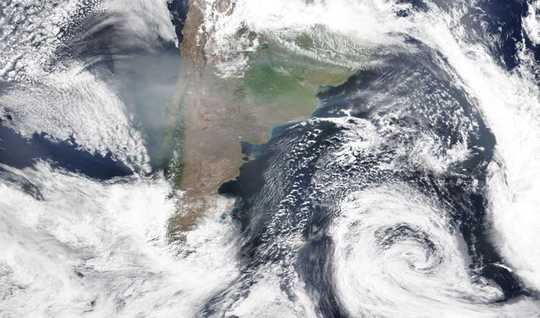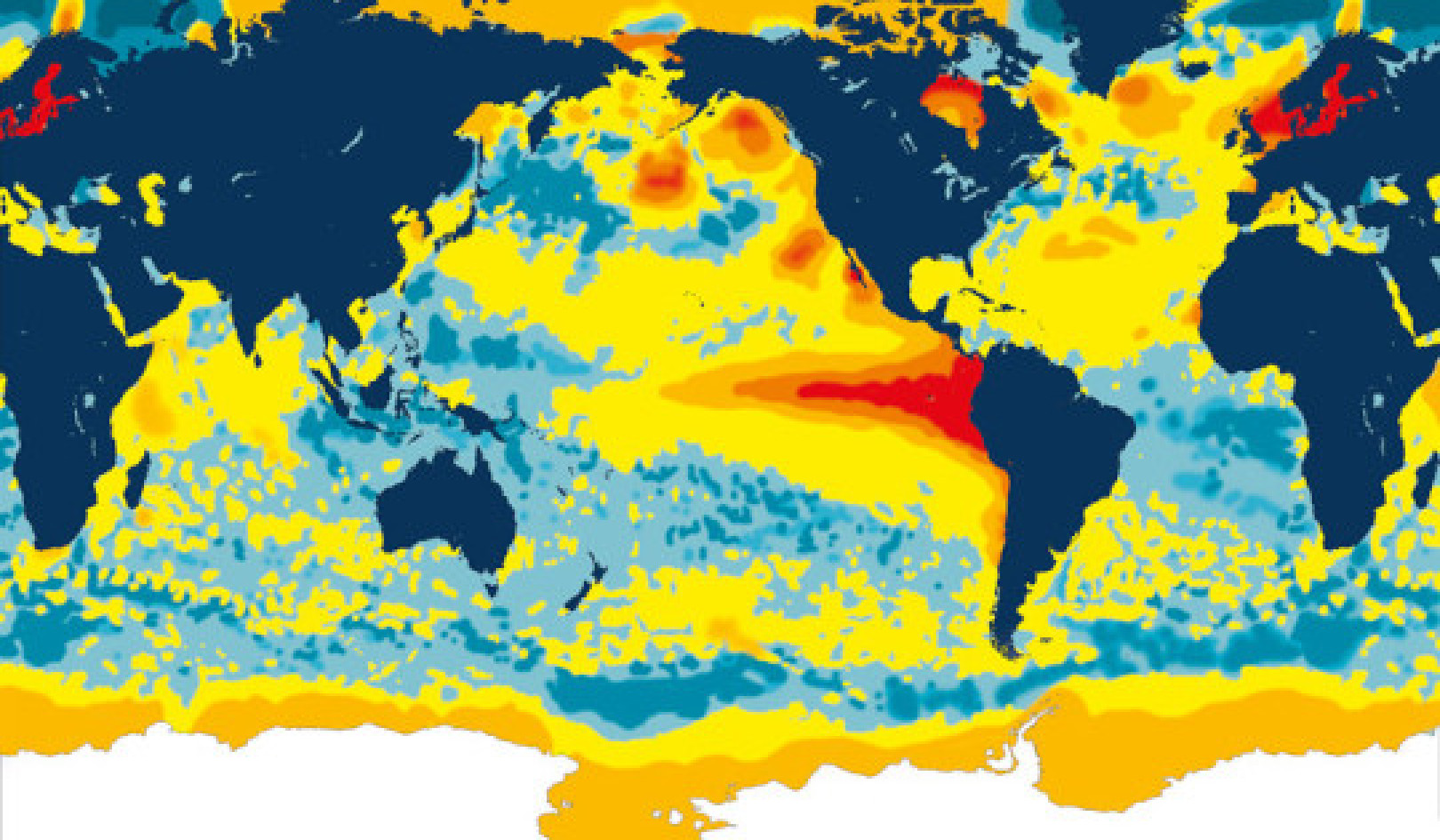 As smoke from Australia’s bushfires streams over South America, bankers are beginning to take seriously the possibility of extreme events. US National Oceanic and Atmospheric Administration
As smoke from Australia’s bushfires streams over South America, bankers are beginning to take seriously the possibility of extreme events. US National Oceanic and Atmospheric Administration
The Bank for International Settlements – the “central bank” for central banks – made headlines in January 2020 with a report outlining how the next major financial crisis may come from unexpected climate risks.
The book calls these risks “green swans” – a play on the term “black swan”, coined by author Nassim Nicholas Taleb. Black swans, Taleb writes in in his 2007 book, are events that are highly improbable, wide-ranging or extreme in their impact and can typically only be explained after they occur.
An example in the financial markets is how the supposedly risk-free investment strategy of the hedge fund Long Term Capital Management in the late 1990s spiralled out of control and nearly took down the global financial system.
Green swans are the climate-related equivalent of black swans.
This is more than just a cute analogy. One of the defining features of black swans is they cannot be modelled using standard mathematical techniques. As the BIS report puts it:
Black swan events can take many shapes, from a terrorist attack to a disruptive technology or a natural catastrophe. These events typically fit fat-tailed probability distributions, i.e. they exhibit a large skewness relative to that of normal distribution (but also relative to exponential distribution). As such, they cannot be predicted by relying on backward-looking probabilistic approaches assuming normal distributions (e.g. value-at-risk models).
Climate risks have the same features:
Climate-related risks typically fit fat-tailed distributions: both physical and transition risks are characterised by deep uncertainty and nonlinearity, their chances of occurrence are not reflected in past data, and the possibility of extreme values cannot be ruled out.
Where green swans differ from black swans is that, given what we know about climate science, it is highly likely there will be extreme, financially devastating effects.
Australia’s recent bushfires are a notable example of the more frequent extreme events expected. In the United States, there have been more than a dozen “billion dollar” climate and weather disasters every year in recent years.
Uncertain certainty
The problem is that we don’t know which extreme climate events will occur. This makes them hard to plan for. It also makes them hard for financial markets to deal with.
If these events could be statistically modelled, at least there would be well-functioning insurance markets for them.
But green swans, by their very nature, defy such predictability.
More than this, green swans can set off cascading additional risks. The BIS book notes:
Climate-related risks are not simply black swans, i.e. tail-risk events. With the complex chain reactions between degraded ecological conditions and unpredictable social, economic and political responses, with the risk of triggering tipping points, climate change represents a colossal and potentially irreversible risk of staggering complexity.
This characterisation of green-swan events seems pretty on point. The big question, of course, is how policy should respond to the presence of these risks.
The BIS report emphasises the role central banks can play.
[…] central banks must also be more proactive in calling for broader and coordinated change, in order to continue fulfilling their own mandates of financial and price stability over longer time horizons than those traditionally considered. We believe that they can best contribute to this task in a role that we dub the five Cs: contribute to coordination to combat climate change.“
The report suggests some things central banks might do. They could keep interest rates lower than they would otherwise be to make "green stimulus” cheaper for governments. They could take account of environmental sustainability goals in determining what securities they hold and the financial stability policies they pursue.
Some of these suggestions I’m not keen on.
I’m for meaningful action on climate change. With co-author Rosalind Dixon, I’ve proposed the Australian Carbon Dividend Plan. I’m also for central bankers highlighting the risks of climate change, as the Reserve Bank of Australia deputy governor, Guy Debelle, has done.
Confusing ends and means
But central banks shifting their mandates to take account of climate risks confuses ends and means.
Yes, climate change is an existential threat. Yes, more needs to be done. And yes, central banks are powerful institutions. But it simply doesn’t follow that they should take on responsibility for policy action on climate change.
One problem is they don’t have the right tools. Central banks can’t impose a price on carbon, for example. The tools they would have to rely on – as the BIS report makes clear – is tinkering with their bond portfolios and keeping interest rates low.
But interest rates are already at historical lows and this hasn’t led to large-scale green stimulus. That is a political problem, not one for central bankers.
A second problem is the potential damage to central banks themselves as institutions. The more central banks are seen as political, the more pressure there will be to make them “accountable” and “democratic”. Such a movement, though well-meaning, could politicise bank boards and damage the virtue of their autonomy.
Climate change hasn’t been addressed by the political process, and that is a tragedy. But asking other powerful institutions to step into the breach might make matters worse, not better. Ultimately, we need to face up to the pressing political problem of climate change.![]()
About the Author
Richard Holden, Professor of Economics, UNSW
This article is republished from The Conversation under a Creative Commons license. Read the original article.
Related Books
Life After Carbon: The Next Global Transformation of Cities
by Peter Plastrik , John Cleveland The future of our cities is not what it used to be. The modern-city model that took hold globally in the twentieth century has outlived its usefulness. It cannot solve the problems it helped to create—especially global warming. Fortunately, a new model for urban development is emerging in cities to aggressively tackle the realities of climate change. It transforms the way cities design and use physical space, generate economic wealth, consume and dispose of resources, exploit and sustain the natural ecosystems, and prepare for the future. Available On Amazon
The future of our cities is not what it used to be. The modern-city model that took hold globally in the twentieth century has outlived its usefulness. It cannot solve the problems it helped to create—especially global warming. Fortunately, a new model for urban development is emerging in cities to aggressively tackle the realities of climate change. It transforms the way cities design and use physical space, generate economic wealth, consume and dispose of resources, exploit and sustain the natural ecosystems, and prepare for the future. Available On Amazon
The Sixth Extinction: An Unnatural History
by Elizabeth Kolbert Over the last half-billion years, there have been Five mass extinctions, when the diversity of life on earth suddenly and dramatically contracted. Scientists around the world are currently monitoring the sixth extinction, predicted to be the most devastating extinction event since the asteroid impact that wiped out the dinosaurs. This time around, the cataclysm is us. In prose that is at once frank, entertaining, and deeply informed, New Yorker writer Elizabeth Kolbert tells us why and how human beings have altered life on the planet in a way no species has before. Interweaving research in half a dozen disciplines, descriptions of the fascinating species that have already been lost, and the history of extinction as a concept, Kolbert provides a moving and comprehensive account of the disappearances occurring before our very eyes. She shows that the sixth extinction is likely to be mankind's most lasting legacy, compelling us to rethink the fundamental question of what it means to be human. Available On Amazon
Over the last half-billion years, there have been Five mass extinctions, when the diversity of life on earth suddenly and dramatically contracted. Scientists around the world are currently monitoring the sixth extinction, predicted to be the most devastating extinction event since the asteroid impact that wiped out the dinosaurs. This time around, the cataclysm is us. In prose that is at once frank, entertaining, and deeply informed, New Yorker writer Elizabeth Kolbert tells us why and how human beings have altered life on the planet in a way no species has before. Interweaving research in half a dozen disciplines, descriptions of the fascinating species that have already been lost, and the history of extinction as a concept, Kolbert provides a moving and comprehensive account of the disappearances occurring before our very eyes. She shows that the sixth extinction is likely to be mankind's most lasting legacy, compelling us to rethink the fundamental question of what it means to be human. Available On Amazon
Climate Wars: The Fight for Survival as the World Overheats
by Gwynne Dyer Waves of climate refugees. Dozens of failed states. All-out war. From one of the world’s great geopolitical analysts comes a terrifying glimpse of the strategic realities of the near future, when climate change drives the world’s powers towards the cut-throat politics of survival. Prescient and unflinching, Climate Wars will be one of the most important books of the coming years. Read it and find out what we’re heading for. Available On Amazon
Waves of climate refugees. Dozens of failed states. All-out war. From one of the world’s great geopolitical analysts comes a terrifying glimpse of the strategic realities of the near future, when climate change drives the world’s powers towards the cut-throat politics of survival. Prescient and unflinching, Climate Wars will be one of the most important books of the coming years. Read it and find out what we’re heading for. Available On Amazon
From The Publisher:
Purchases on Amazon go to defray the cost of bringing you InnerSelf.comelf.com, MightyNatural.com, and ClimateImpactNews.com at no cost and without advertisers that track your browsing habits. Even if you click on a link but don't buy these selected products, anything else you buy in that same visit on Amazon pays us a small commission. There is no additional cost to you, so please contribute to the effort. You can also use this link to use to Amazon at any time so you can help support our efforts.




























